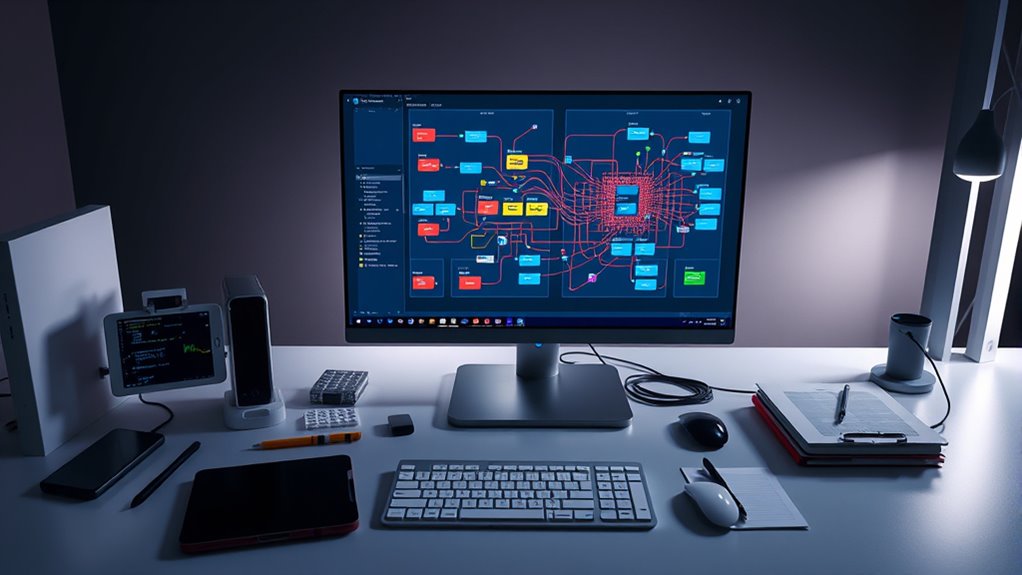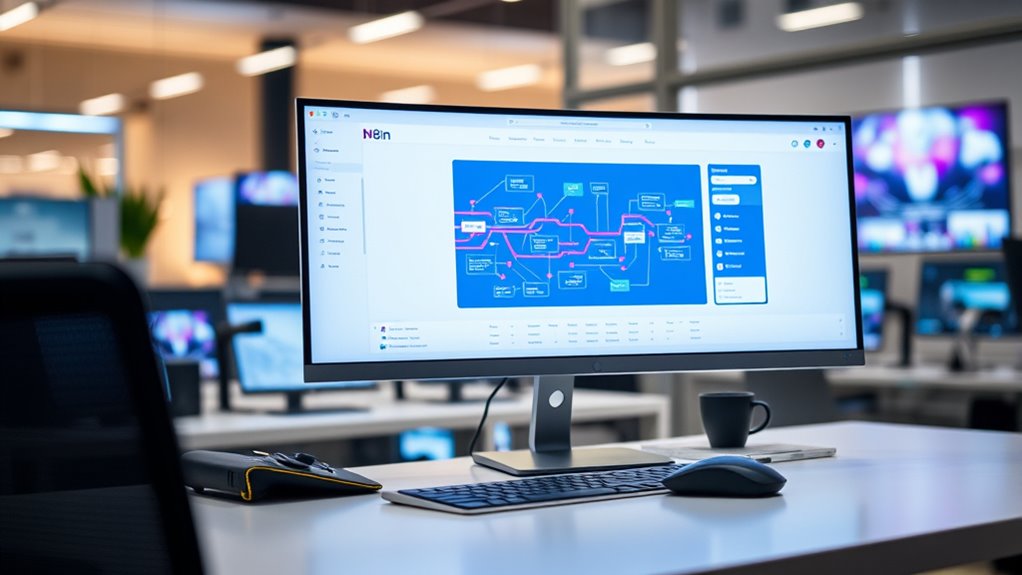To build end-to-end workflows in N8n, start by understanding its core components, such as nodes and their configurations. Plan and map out your process visually, identifying key data points and connections. Connect your apps through API integrations and set triggers to automate actions based on events like form submissions or file uploads. Test and optimize your workflow regularly to guarantee it runs smoothly. Keep exploring to reveal the full potential of your automation.
Key Takeaways
- Plan and map the entire workflow visually to identify data flow and task sequence before building in N8n.
- Use nodes to represent each task, configuring triggers, actions, and app integrations for seamless automation.
- Connect apps via API nodes to enable real-time data exchange and synchronization across platforms.
- Test each component thoroughly, utilizing error workflows and debugging tools to ensure smooth execution.
- Optimize the workflow by streamlining nodes, removing redundancies, and regularly updating for performance and reliability.
Understanding N8n and Its Core Components

N8n is an open-source workflow automation tool designed to connect various apps and services seamlessly. At its core, it uses nodes to represent different tasks or actions within a workflow. Understanding how these nodes work is essential for effective node configuration. Each node performs a specific function, such as fetching data, transforming information, or triggering events. When you set up your workflow, you’ll connect nodes to define the process flow, enabling automation across multiple platforms. N8n’s visual interface simplifies node configuration, allowing you to customize each node’s settings easily. By mastering these core components, you can build complex, efficient workflows that automate repetitive tasks, saving you time and reducing errors. Additionally, understanding workflow design principles helps in creating more effective and scalable automations. This foundational understanding sets the stage for designing more sophisticated automations.
Designing Your Workflow: Planning and Mapping Processes

Before building your workflow, it’s essential to plan and map out your processes to guarantee a smooth automation experience. Use visual mapping to create a clear picture of each step, helping you see how data flows and tasks connect. Process visualization allows you to identify potential bottlenecks or redundancies early, saving time later. By sketching your workflow first, you ensure all necessary components are included and properly sequenced. This planning phase helps you understand dependencies and define triggers, making the actual setup straightforward. Keep your map simple and organized, focusing on key actions and decisions. A well-designed plan provides a solid foundation, ensuring your automation runs smoothly and efficiently from start to finish. Additionally, understanding the currency fluctuations and their impact on processes can help optimize your workflow for international transactions.
Connecting Apps and Integrating Data Sources

Connecting your apps and integrating data sources is an essential step in building a seamless workflow. With N8n, you can set up API integrations to connect various services effortlessly. This allows you to fetch, send, and update data across platforms in real-time. Data synchronization ensures that your information stays consistent between apps, reducing errors and manual updates. To do this, you’ll configure nodes that communicate via APIs, enabling smooth data flow. Whether integrating a CRM, email marketing tool, or cloud storage, N8n simplifies connecting these apps without extensive coding. Establishing reliable projector image quality through data integration can enhance your control over media environments. By establishing these connections, you create a unified environment where data moves seamlessly, empowering you to automate processes and maintain accurate, up-to-date information across all your systems.
Automating Tasks With Triggers and Actions

Have you ever wondered how to make your workflows respond automatically to specific events? Using workflow triggers, you can initiate action sequences instantly when certain conditions occur. To visualize, here’s a simple breakdown:
| Trigger Event | Action Sequence | Result |
|---|---|---|
| New form submission | Send confirmation email | User receives instant reply |
| File upload | Save file to cloud storage | File organized automatically |
| Payment received | Update CRM system | Customer record updated |
Additionally, designing your workflows with a clear concept of workflow automation ensures efficiency and reliability.
Testing, Debugging, and Optimizing Your Workflow

To guarantee your workflow runs smoothly and achieves the desired results, it’s essential to test, debug, and optimize it continuously. Start by monitoring error handling to identify where issues occur, and use N8n’s built-in error workflows to manage failures effectively. Debug by inspecting node logs and outputs, pinpointing bottlenecks or misconfigurations. Performance tuning involves streamlining your nodes, reducing unnecessary actions, and using efficient triggers. Regular testing ensures each component functions correctly before deploying updates. Remember, optimizing isn’t a one-time task; revisit your workflow periodically to improve speed and reliability. Proper error handling and performance tuning help you maintain a resilient workflow, minimizing downtime and ensuring consistent results. Stay vigilant, and your automation will perform at its best. Additionally, detecting passive voice can help improve clarity and engagement in your documentation and comments.
Frequently Asked Questions
How Secure Is Data Transmission Within N8N Workflows?
You might wonder about data security within n8n workflows. Rest assured, it uses data encryption to protect your information during transmission, reducing risks of interception. Additionally, n8n offers access controls, allowing you to restrict who can view or modify workflows and data. This combination of data encryption and access controls helps guarantee your data remains secure, giving you confidence in the safety of your information as it moves through your workflows.
Can N8N Handle Complex Conditional Logic and Branching?
You’ll find that n8n handles complex conditional logic and branching workflows effectively. It provides a variety of nodes that let you implement decision points, enabling your workflows to branch based on specific conditions. You can easily design workflows that adapt dynamically, making your automation more flexible and powerful. With n8n, managing intricate decision trees becomes straightforward, helping you build sophisticated processes without needing extensive coding knowledge.
What Are Best Practices for Scaling Workflows in N8N?
Imagine your workflows as a bustling highway, where traffic flows smoothly every lane. To scale effectively in n8n, you should adopt scaling strategies like load balancing and workload optimization. Break large workflows into smaller, modular parts, and use queues or parallel execution. Keep an eye on performance metrics, and optimize nodes to prevent bottlenecks. This way, your system remains efficient and ready for growth.
How Does N8N Support Version Control and Collaboration?
You can leverage n8n’s workflow versioning to track changes and easily revert to previous states, ensuring stability. The platform also offers collaboration tools like shared workflows and real-time editing, making teamwork seamless. By using these features, you support smooth collaboration and maintain organized, up-to-date workflows. This approach helps you manage updates effectively and encourages a collaborative environment, boosting productivity and reducing errors.
Are There Limitations on Workflow Execution Frequency or Volume?
Imagine your workflow as a busy highway—n8n enforces workflow throttling and execution quotas like traffic cops, preventing crashes. While it handles many tasks smoothly, there are limits on how often or how much you can run workflows. If you push too hard, you’ll hit these caps, causing delays or pauses. So, yes, there are constraints, but they’re designed to keep your automation running reliably without overloads.
Conclusion
Building end-to-end workflows in n8n empowers you to automate complex processes effortlessly. Did you know that organizations that automate workflows see a 30% increase in efficiency? By understanding core components, planning carefully, connecting apps seamlessly, and continuously testing, and discover significant productivity gains. Start designing your workflows today, and watch how automation transforms your daily tasks into streamlined, intelligent processes that save time and reduce errors.









